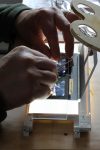
Taping it down
Many years ago, I published a process for mounting film chips in slide mounts. It involved a lot of fiddling with temporary bits of tape, and scraps of plastic to protect the film from fingerprints. I’ve replaced all of that by using a long, thin piece of clear plastic to help me manipulate the film.
]]>Sometimes, however, I want to see the image in a viewer before making my decision. In these cases, I follow a tip from Paul Talbot. I reach for one of my protective sleeves, slip my cut & reversed film chips in, and drop it into my viewer. The images aren’t precisely aligned, but they are often close enough. This technique also lets me try different mount apertures by holding them in front of the image.
If my cross-eye preview of the uncut film finds a promising image, I cut it from the roll. If this still looks like a candidate for mounting, I snip the halves apart and swap them left for right.
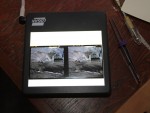
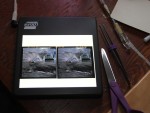
Then I can slip each half into a slide cover. “Alignment” consists of smacking the bottom edge of the sleeve against the table. This settles both image halves at the bottom of the sleeve. It isn’t precise. It doesn’t set the window. It’s just “good enough”.
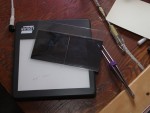
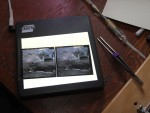
By dropping the image in a viewer, I can decide if it deserves more time and precision mounting. If so, I select a suitable mount and finish the job.
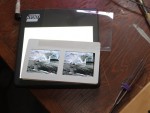
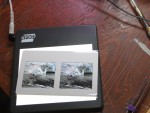
If the image isn’t worthy of a mount (or the time required), I’ll usually leave the halves in the sleeve. The next time I’m pawing through my box, I may change my mind and give it a mount.
]]>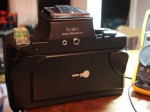 As part of my continuing tinkering, I have provided an external power jack on one of my TL120 cameras. The full story gets its own page.
As part of my continuing tinkering, I have provided an external power jack on one of my TL120 cameras. The full story gets its own page.
The camera can now accept power from any external battery which can deliver between 5 and 32 volts. Long exposures and cold temperatures are no longer things to be afraid of. I’m planning on using a 12v lithium from a cordless drill. It should be able to deliver the goods even when the temperatures fall below freezing.
]]>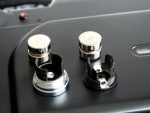 Over the years, there have been many comments on the mailing lists about the batteries in the TL120 camera. Over the years, I have measured and offered suggestions about these concerns. I have recently done more measurements and collected my information onto a single page.
Over the years, there have been many comments on the mailing lists about the batteries in the TL120 camera. Over the years, I have measured and offered suggestions about these concerns. I have recently done more measurements and collected my information onto a single page.
Summary: The button cells used in the TL120 are not a very good match for its requirements. But since the camera is designed to use them,
- Use SR44 batteries
- Do not use LR44 batteries
- Keep a set of PR44 batteries in your camera bag as backup
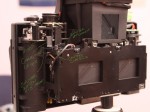 And since I was going in, it seemed like a good idea to take pictures and document it for the next person.
And since I was going in, it seemed like a good idea to take pictures and document it for the next person.
You can get your camera, a pair of tweezers, a couple of screwdrivers, and follow along!
There are a lot of pictures and process takes a lot of space to describe, so it gets its own page.
]]>
- Range of focus
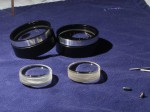
- Accuracy of colors
- Limited distortion
- Eye relief
- Interocular adjustments
- Field of view
Different people value different features. No single viewer is going to make everyone happy.
There are those who strive to realistically recreate the the scene the camera saw at the time the image was made. I have, however, long been intrigued by wide-angle viewing regardless of the focal length of the lenses on the camera. I’ve wanted to get closer to the image and become part of it.
One of my experiments on this path involved replacing the lenses in a 3D-World focusing viewer with 60mm lenses. The resulting viewer looked just like the original, and it brought me closer to my images. That, however, is a topic for a different posting.
A posting to the MF3D mailing list in October 2011 and a subsequent phone conversation with Don Lopp convinced me to try a different approach. It starts with 50mm diameter binocular objectives, and 39mm achromatic eye pieces. The two elements are placed about 25mm apart. The  alignment of the two elements needs to be pretty precise. Deviations in the planes of the lenses or optic centers become apparent very quickly.
alignment of the two elements needs to be pretty precise. Deviations in the planes of the lenses or optic centers become apparent very quickly.
I started by hand-holding the elements above a slide. With two elements per eye, this wasn’t very practical and I mounted the elements in two pieces of wood. By placing them parallel to each other, at least the alignment was constrained in one dimension and everything was easier to hold. With a little trial and error, the lens boards were balanced on a section of cardboard which gave a fairly well focused image. The range of focus was very small, so inaccuracies in the cardboard, 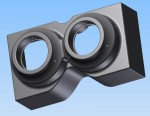 tape and plywood construction were obvious. The resulting image, however, was big enough to keep me engaged and urge me to continue the experiment.
tape and plywood construction were obvious. The resulting image, however, was big enough to keep me engaged and urge me to continue the experiment.
My brief efforts with hand tools had shown that I was not going to be able to achieve the required precision and alignment required to get the best out of my lens elements. I chose to pursue 3D-printing as a way to create a prototype with the correct tolerances. With no practical experience with 3D modeling or CAD, I was still able to work with a trial version of Autodesk Inventor and produce a viable model in exactly a month.
Printing the model required a week and cost about $100. When it came out of the shipping box, the lens elements fit in with only extremely minor sanding to the plastic. The resulting image through the viewer was superior to the plywood/cardboard version and justified the investment of time and money in the 3D design and printing.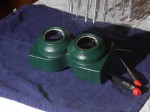
Next Time: Dimensions, the viewing experience, and the next phase
]]>
As Originally Printed
The book wasn’t bad, but it wasn’t terrific, either. I solicited some comments and suggestions and made some edits to it. The edited book was never printed. It was just an on-line evaluation tool.
With Later Adjustments
]]>
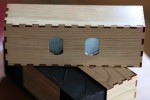 There are many devices to assist viewing large print and screen images. I’ve tried a few, though certainly not all. I’ve just been working with a Wheatsone viewer from Mark Golebiowski who is selling them in kit form at www.fullscreenviewer.com
There are many devices to assist viewing large print and screen images. I’ve tried a few, though certainly not all. I’ve just been working with a Wheatsone viewer from Mark Golebiowski who is selling them in kit form at www.fullscreenviewer.com
I had the opportunity to try this viewer at the 2010 NSA convention in Ohio. It felt nice in my hands, was easy to use and worked well with very large prints. When the opportunity came along to exhibit a couple of my own images, I knew I wanted to use this viewer.
I ordered a pair of viewers and had the kits in my mailbox three days after I placed my order. They came thoughtfully packaged and arrived in perfect condition. I commend Mark on attention to detail as not everyone takes the time to correctly package items being shipped to Alaska.
The kit consists of parts to build a nested-box Wheatsone viewer. 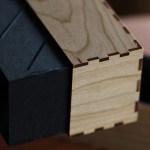 The outer box is of 3mm cherry. The inner box is of 1.5mm matte board. The four mirrors are first-surface glass. Printed instructions are provided as well as pre-sale access to a PDF of the instruction on the web. Really, though, assembly is simple enough that the instructions are extraneous. The only part that might trip some folks up are the first-surface mirrors and those are fully explained in the instructions.
The outer box is of 3mm cherry. The inner box is of 1.5mm matte board. The four mirrors are first-surface glass. Printed instructions are provided as well as pre-sale access to a PDF of the instruction on the web. Really, though, assembly is simple enough that the instructions are extraneous. The only part that might trip some folks up are the first-surface mirrors and those are fully explained in the instructions.
The time required to assemble the viewer is really a personal choice. I invested about two hours over the course of three days to assemble and finish my two viewers. Most of that time was spent in the finishing. I chose to use a polyurethane finish and laid four coats down on each viewer. They look and feel great, but each coat required brush-cleaning-time and drying. There are other finishes which would go on more quickly.
After seeing how precisely the laser-cut parts had been cut, 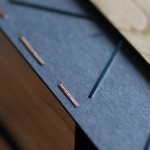 I deviated a little from the suggested assembly sequence. Rather than beginning the assembly with two perpendicular sides, I chose to dry-fit one entire “box”. I taped the sides of the box together with blue masking tape and removed the top. I then glued the top to the two long sides of the box and waited for the glue to dry while using the rest of the box as the “clamping jig”. When the glue was dry, I glued each “end” back into the box and waited for them to dry. The laser-cut parts fit tightly enough that later investigation with a square revealed nothing but right-angles. I used the same process for both the inner and outer boxes.
I deviated a little from the suggested assembly sequence. Rather than beginning the assembly with two perpendicular sides, I chose to dry-fit one entire “box”. I taped the sides of the box together with blue masking tape and removed the top. I then glued the top to the two long sides of the box and waited for the glue to dry while using the rest of the box as the “clamping jig”. When the glue was dry, I glued each “end” back into the box and waited for them to dry. The laser-cut parts fit tightly enough that later investigation with a square revealed nothing but right-angles. I used the same process for both the inner and outer boxes.
When done, the viewer is simple to use. Point the widely spaced openings towards your image and look through the eye holes. Because the mirrors are at fixed angles to each other, being too near an image pair will crop some of the image. Being too far will prevent the image from filling your view. My unscientific observations with a few prints and a tape measure show my perception of the usable print-size:viewing-distance ratio (measurements are in inches).
| “Chip” Size | Near viewing distance | Far viewing distance |
| 5 | 17 | 20 |
| 8 | 24 | 28 |
| 10 | 32 | 38 |
I am very pleased with the kit and the viewing experience it offers. Thank you, Mark, for your efforts!
]]>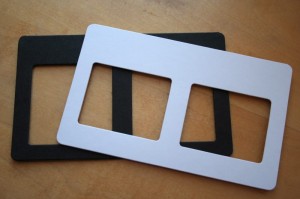
50x50 and 50x40 mounts
What good is an image if you can’t view it?
How can you view your image if you can’t mount it?
There are several mounts from which to choose. How are they simmilar and how do they differ?
I’ve gathered some information on the multiple mounts available for medium format stereo slides.
]]>